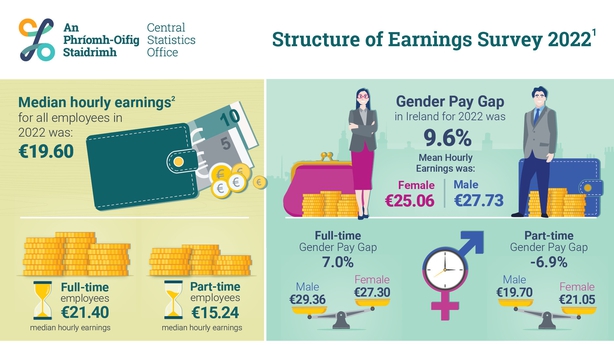Men earned 9.6% more than women last year, according to the latest figures from the Central Statistics Office today.
The Gender Pay Gap, however, shows considerable variation across sectors and job types.
Today's publication shows that there are big differences across sectors, age groups and job types in how women are paid compared to men.
The CSO finds that the Gender Pay Gap was highest in the financial, insurance and real estate sectors at 24.7% while it was lowest in the education sector at 2.7%.
It also finds that men, on average, worked an average of 35.7 hours per week while females worked an average 30.1 hours per week.
The Gender Pay Gap is an average figure and does not measure differences in pay between men and women who perform the same job.
The pay gap is highest in the private sector compared to the public sector, where women on average are paid slightly more.
We need your consent to load this rte-player contentWe use rte-player to manage extra content that can set cookies on your device and collect data about your activity. Please review their details and accept them to load the content.Manage Preferences
Also, when it comes to part-time work, females are on average paid more. In general, the pay gap declines the bigger the firm.
The pay gap is in favour of women between the ages of 15-24 but then favours men as working lives progress.
This survey is carried out by the CSO every four years, with no reporting of median earnings between publications. The last survey in 2018 showed median earnings at €17.10.

The difference between mean, or average, earnings per hour and median earnings per hour in 2022 was 34.7%. Median earnings mark the mid-point up to which half of those in the workforce earn.
The Gender Pay Gap was 11.3% in 2018, although the CSO points out that neither the public sector nor smaller firms with up to nine employees were included in that report.
The Gender Pay Gap is reported annually by Eurostat, based on information supplied by the CSO. It says the methodology differs from that used by the CSO.
On the Eurostat measure, the Gender Pay Gap in 2020 was 9.9% compared to an EU average of 12.7%.
Today’s report finds median or mid-point hourly earnings across the economy was €19.60 last year with ICT paying the most at €31.97 an hour while the lowest was in the Accommodation and Food Services sector at €13.59 an hour.
Wages also increase according to qualifications, the CSO noted.
Those with a doctorate or higher earned the most at €39.92 with 38.8 weekly hours. The lowest median hourly wages were paid to those with no formal education at €14.73 with 36.5 median hours.






